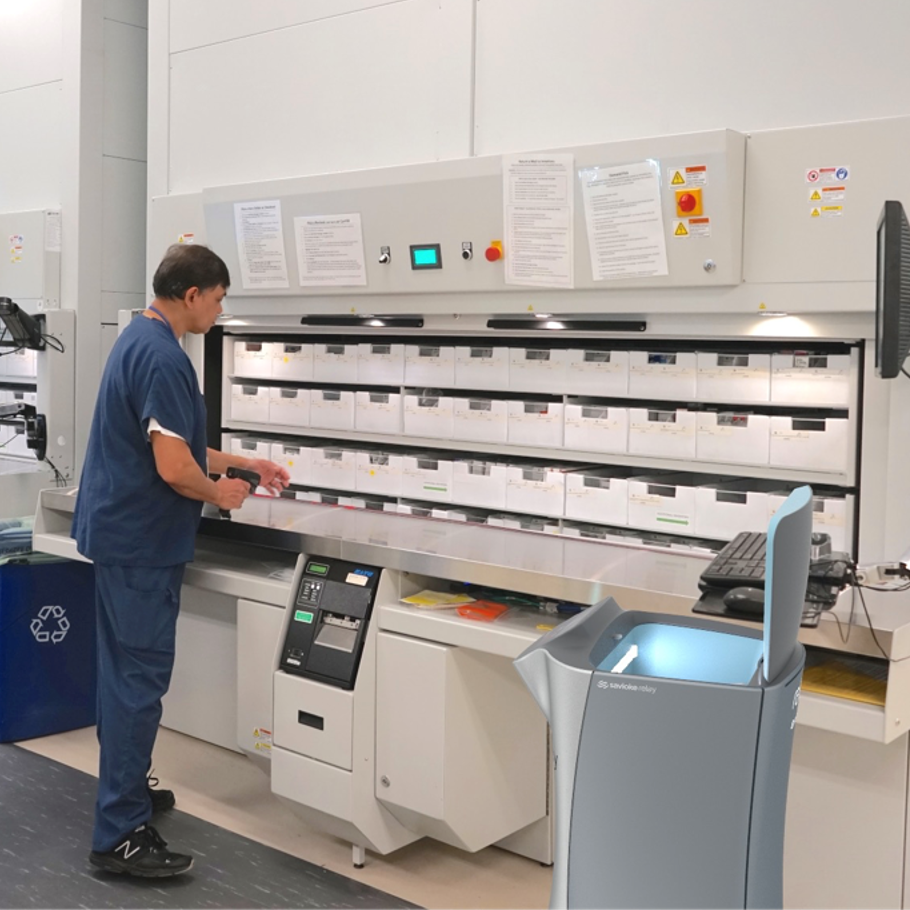According to recent statistics from the Bureau of Labor Statistics (BLS), the demand for pharmacy technicians is projected to soar 7% in the coming years. However, the number of qualified professionals falls short of meeting this demand, leading to overburdened pharmacy teams and potential service lapses.
Similar to nursing, the shortage of pharmacy technicians is a growing concern, as demand for their services outpaces the available workforce. Recent trends such as an aging population, expanded access to healthcare services, and increasing prescription volumes are creating this crisis.

Enter Hospital Delivery Robots
As hospital pharmacies across the country face a severe shortage of pharmacy technicians, the need for innovation has never been more apparent. Hospital delivery robots are an efficient and cost-effective solution to automate the process of medication deliveries, freeing pharmacy technicians to concentrate on the crucial task of filling prescriptions and contributing to patient care.
Pharmacy use cases for hospital delivery robots include:
Hospital delivery robots like the state-of-the-art autonomous RelayRx are equipped to safely navigate hospital environments and deliver medicines to locations and departments within the facility like nurses’ stations, the chemotherapy infusion center, or the outpatient lounge. These robots are revolutionizing healthcare delivery systems by reducing human intervention, streamlining processes, and ensuring efficiency with every roll of their wheels.
Here are eight compelling reasons why pharmacies should consider incorporating hospital delivery robots into their operations:
1. Reduce costs
With salaries for skilled healthcare workers continuing to rise, paying the monthly RaaS — Robot as a Service — fee to perform high-volume routine deliveries all over the hospital is exponentially cheaper than employing a skilled pharmacy technician to make deliveries.
2. Streamline pharmacy processes
Studies show that being bored at work contributes to burnout. By shifting the responsibility of mundane deliveries to robots, pharmacy technicians can dedicate more time to their meaningful work of filling prescriptions, consulting with patients, and managing pharmacy operations. This streamlined workflow leads to enhanced patient care and pharmacy team satisfaction.
3. Enhance efficiency and accuracy
Hospital delivery robots are designed to learn the fastest route to its destination and deliver medications promptly (including riding elevators and navigating automated doors). Unlike human staff, they do not experience fatigue or distraction, ensuring accurate and timely deliveries
4. Provide always-on service
Service delivery robots operate 24/7, ensuring that pharmacies are able to meet the demands of patients even during peak hours or emergencies. This consistent service is critical for hospitals that need to urgently deliver medications at any time of the day or night.
5. Spend more time with customers
With robots unburdening pharmacists from making deliveries, pharmacy workers can focus on interacting with patients, answering their questions, and alleviating their concerns regarding their medications. This personalized approach fosters stronger patient-pharmacist relationships, leading to better health outcomes.
6. Integrate with existing systems to strengthen chain of custody for medications
Hospitals can work to integrate hospital delivery robots into their operations and critical workflows, enabling pharmacies to provide end-to-end chain of custody for all medications.
7. Scale to gain greater efficiencies
Hospital delivery robots are designed to scale to accommodate the needs of all pharmacy operations. Hospital pharmacies can deploy multiple robots to handle medication demands or implement a robot at every pharmacy throughout the hospital, including the outpatient pharmacy to deliver discharge prescriptions.
8. Offer customers contactless service to reduce risk of transmission
Global health crises continue to persist, and hospital pharmacies must stay vigilant in their quest to keep patients safe. Hospital delivery robots help to satisfy this need by facilitating contactless delivery, reducing the risk of transmission.
The Bottom Line: Hospital Delivery Robots are lifesavers for hospital pharmacies
The shortage of pharmacy technicians is an imminent challenge that hospital pharmacies must address. Embracing hospital delivery robots is a forward-thinking solution that not only addresses this shortage but also enhances pharmacy operations, patient care, and overall efficiency. Pharmacies can delegate the task of deliveries to hospital delivery robots and free up their skilled pharmacy technicians to focus on the critical workflow of filling prescriptions and providing personalized care to patients.
As the healthcare landscape continues to evolve, pharmacies must leverage cutting-edge technologies to optimize their services. Hospital delivery robots offer a path to a more streamlined and patient-centric future. Embracing this technology today will not only alleviate the existing burden on pharmacy technicians, but also position pharmacies for greater success in the years to come. Hospital pharmacies should seize this opportunity and work to transform the healthcare industry with service delivery robots.
About Relay Robotics
Relay Robotics (formally Savioke) is a leading supplier of autonomous service robots that work with humans safely, securely, reliably, and contact-free. Relay’s robots complement staff across healthcare and hospitality. They have completed more than 1,400,000 deliveries worldwide and continue to make hundreds of deliveries a day around the globe. To learn more, contact us.
Relay delivery robots are currently deployed at major hotels in the United States such as Marriott, Hilton, Westin, Mandarin Oriental, Holiday Inn, and Radisson, nationally recognized hospitals such as MedStar Georgetown, , Yale New Haven, El Camino Health, CHU Sainte Justine, and Santa Clara Valley Health. Relay robots are available via a monthly subscription or RaaS (Robots as a Service). Relay’s Rapid-Install™ trains and activates a robot within hours of arrival at a location so they can seamlessly ride elevators, interface to automated doors, and navigate the entire property. Customers can name their robot and create a customized “wrap” to give it a unique character and harmonize it with their brand.
